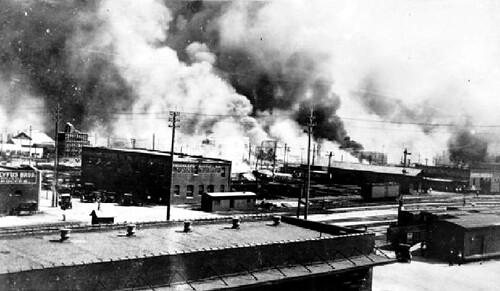
Tulsa Race Riots 1921: photo by naerae, 22 May 2011
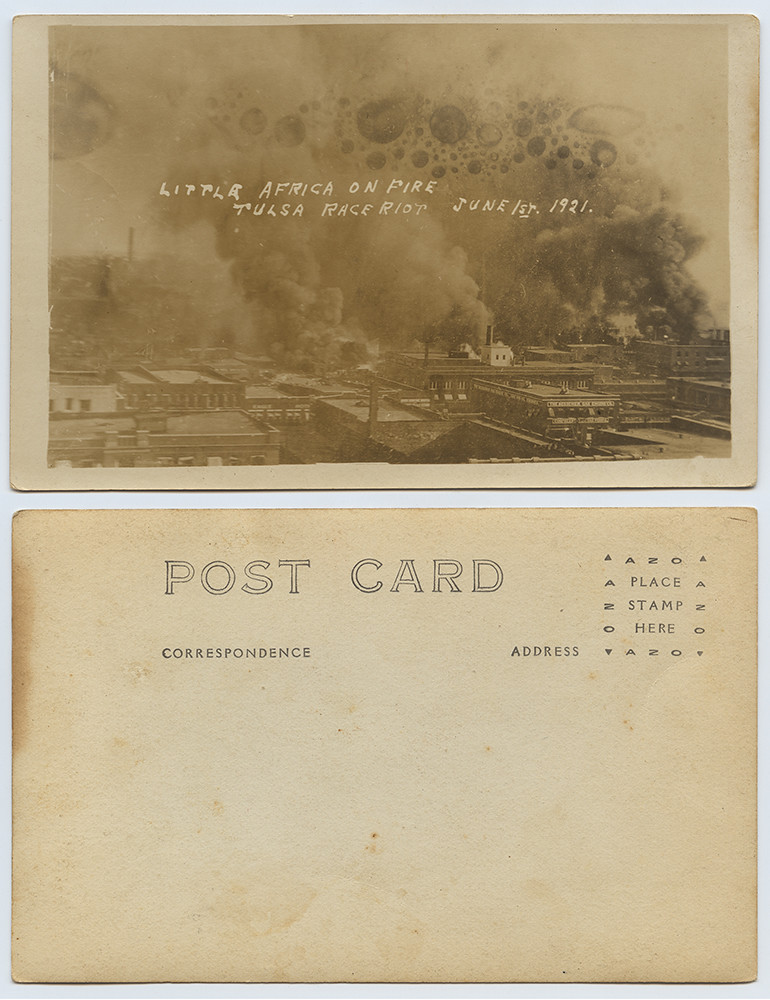
Little Africa on Fire, Tulsa Race Riot, June 1st, 1921 (Greenwood District, Tulsa, Oklahoma): photographer unknown, 1 June 1921 (De Golyer Library, Southern Methodist University)
![Burning of Church where Amunition [sic] Was Stored - During Tulsa Race Riot, 6-1-21 | by SMU Libraries Digital Collections](https://c1.staticflickr.com/3/2907/14389841381_76e95fb738_b.jpg)
![Chared [sic] Negro - Killed in Tulsa Riot, 6-1-1921 | by SMU Libraries Digital Collections](https://c1.staticflickr.com/4/3886/14391369732_661237d849_b.jpg)
Char[r]ed Negro Killed in Tulsa Riot, 6-1-1921 (Greenwood District, Tulsa, Oklahoma): photographer unknown, 1 June 1921 (De Golyer Library, Southern Methodist University)

Negro Slain in Tulsa Riot, 6-1-1921 (Greenwood District, Tulsa, Oklahoma): photographer unknown, 1 June 1921 (De Golyer Library, Southern Methodist University)
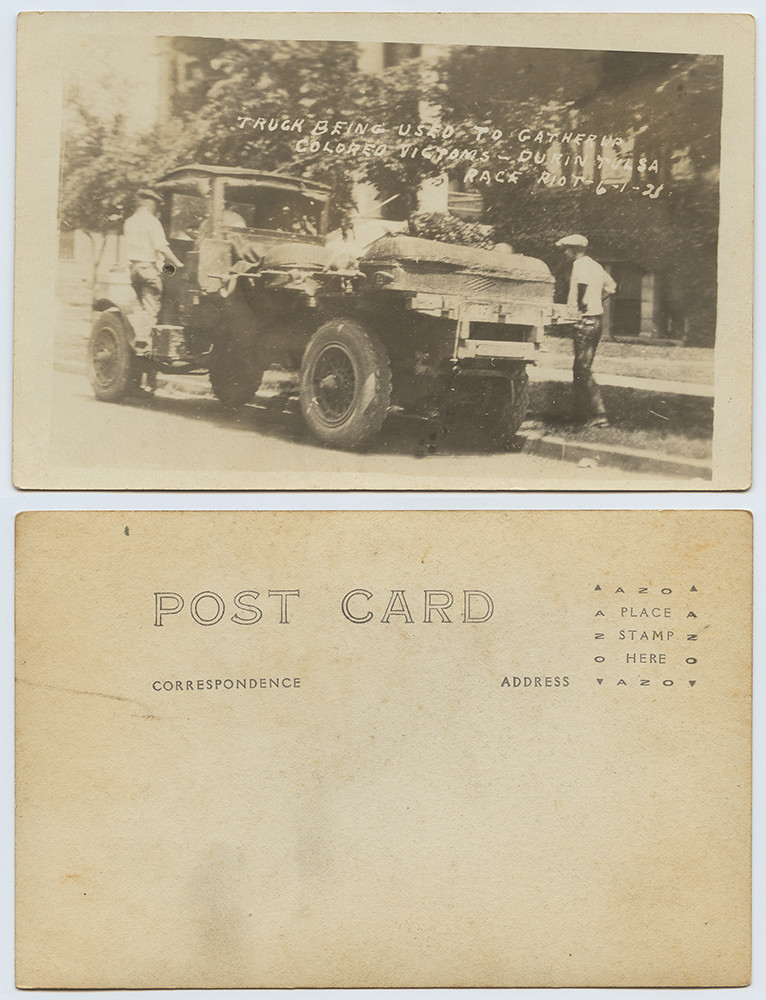
Truck Being Used to Gather up Colored Victims - During Tulsa Race Riot, 6-1-21 (Greenwood District, Tulsa, Oklahoma): photographer unknown, 1 June 1921 (De Golyer Library, Southern Methodist University)

Scene During Tulsa Race Riot, June 1st, 1921 (Greenwood District, Tulsa, Oklahoma): photographer unknown, 1 June 1921 (De Golyer Library, Southern Methodist University)
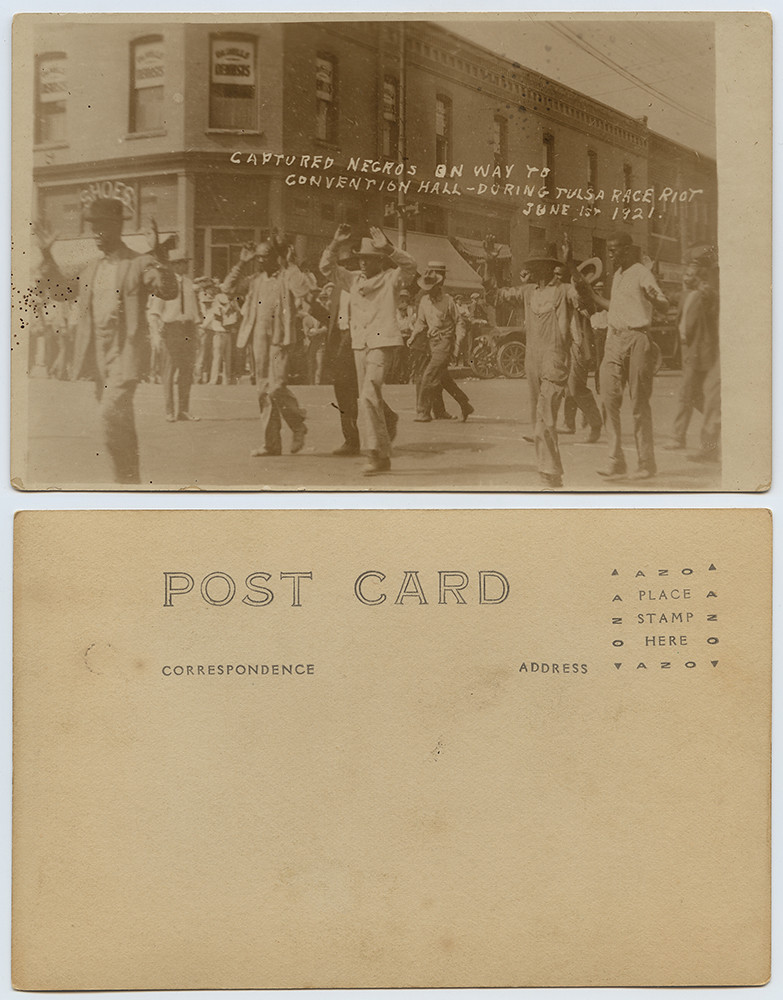
Captured Negros on Way to Convention Hall - During Tulsa Race Riot, June 1st, 1921 (Greenwood District, Tulsa, Oklahoma): photographer unknown, 1 June 1921 (De Golyer Library, Southern Methodist University

Tulsa Race Riot, June 1st, 1921. Scene at Convention Hall. (Greenwood District, Tulsa, Oklahoma): photographer unknown, 1 June 1921 (De Golyer Library, Southern Methodist University)
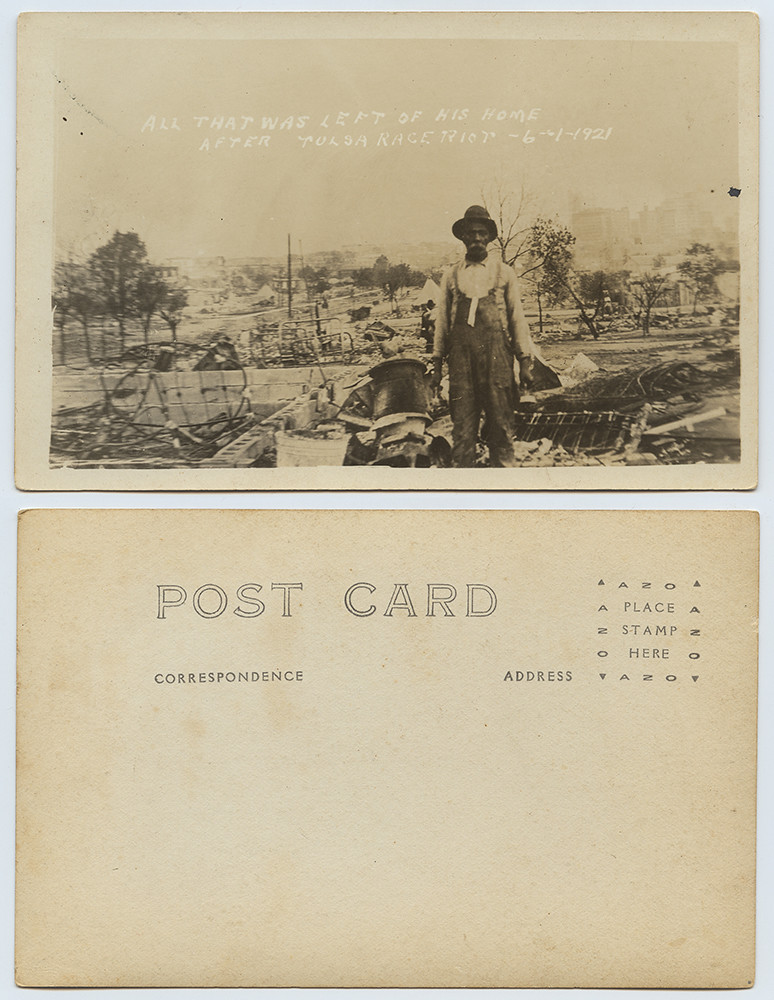
All That Was Left of His Home after the Tulsa Race Riot, 6-1-1921. (Greenwood District, Tulsa, Oklahoma): photographer unknown, 1 June 1921 (De Golyer Library, Southern Methodist University)
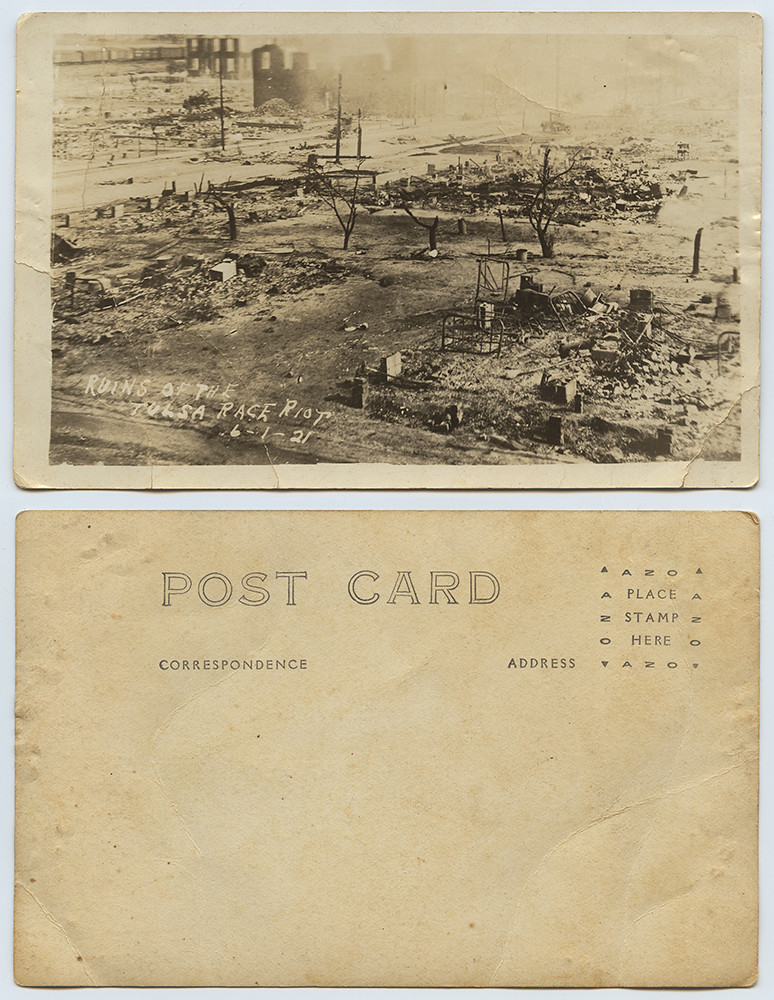
Ruins of the Tulsa Race Riot, 6-1-21 (Greenwood District, Tulsa, Oklahoma): photographer unknown, 1 June 1921 (De Golyer Library, Southern Methodist University)

Ruins of the Tulsa Race Riot, 6-1-21 (Greenwood District, Tulsa, Oklahoma): photographer unknown, 1 June 1921 (De Golyer Library, Southern Methodist University)

Ron Padgett: Tulsa Race Riots, 1921
Dick
Rowland stepped on Sarah Page’s foot
and she
lets out a scream.
Rowland, a
19-year-old bootblack,
flees the
elevator. Sarah Page, a 17-year-old part-time
elevator operator
in the Drexel Building
and
divorcée attending business college,
tells those
who rush to her aid that
he had
assaulted her.
Later that
afternoon two black police officers
arrest
Rowland at his home and take him
first to
the City Jail, then the County Jail.
That
evening’s Tulsa Tribune carries a small story
of the
alleged assault, and rumors of rape
spread
through town. By 4 p.m.
Commissioner
of Police J. M. Adkinson reports to Sheriff McCullough
that
there’s talk of lynching Rowland.
Others
confirm this report. Rumor of a lynching
reaches
“Little Africa,” where Tulsa’s 15,000 Negroes live.
Blacks
phone Sheriff McCullough to offer their services
to protect
Rowland from a lynch mob.
(Less than
a year before, in July of 1920,
Roy Belton,
a white man accused of murdering a cab driver,
was taken
from the Tulsa County Jail and lynched.
Witnesses
stated that local police officers
had
directed traffic at the lynching. The presence of a strong
and active
Klan in Tulsa added to the fear of a lynching.)
By 9 p.m.
about 400 white men have gathered outside the jail.
At 9:15
word reaches Little Africa
that the
mob had stormed the jail.
About 25
armed blacks drive to the jail and find
this rumor
to be untrue. They leave,
but soon
return with about 50 more armed blacks.
Sheriff
McCullough persuades them to leave
and a white
man tries to disarm a black.
A shot is
fired.
According
to the sheriff, “All hell breaks loose,”
firing from
both sides. Twelve fall dead,
2 black and
10 white.
Pitched and
running gun battles rage
around the
County Jail at Sixth and Boulder
and spread
from there. Whites break into
pawnshops,
hardware and sporting goods stores
to loot for
guns, ammunition and what-have-you.
The
fighting continues, groups of men surging through the streets,
excited,
angry and terrified, unreal.
By midnight
the blacks are forced to fall back
to Little
Africa. One-half block (North Cincinnati
between
Archer and the Frisco Railroad)
composed of
Negro pool halls, whorehouses, and restaurants
bursts into
flame. The blacks fall further back,
as far as
North Greenwood, the main business street of Little Africa.
The
fighting abates somewhat during the early morning hours
of
Wednesday, June 1st, but sporadic shots are heard
throughout
the night. The Final edition of the Tulsa World proclaims,
“Two Whites
Dead in Race Riot.” An Extra edition appears with
“New
Battles Now In Progress.” About 5 a.m.
10,000
white men (and Mexicans) assault Little Africa—
the total
white population of Tulsa is 57,000, 7,000
of whom
were in uniform for World War I—using small arms,
rifles,
shotguns, machine guns, and 6 airplanes
for
reconnaissance. The World brings out a Second Extra!
“Many More
Whites Are Shot.” By this time
many blacks
have fled town or are in hiding
with their
white employers. The white army
rolls
through “Niggertown,” killing the black men they see,
looting
houses and businesses and dousing them with kerosene.
One
eyewitness said, “Cars began to drive slowly
along our
street. Cars driven by the sort of men
who wear
their caps backward, the visors down their necks.”
The Fire
Department and National Guard are powerless
against the
mob. The fires rage all morning:
800 stores
and homes burned to the ground,
the
business district of Little Africa completely destroyed.
Later that
morning the last black stronghold,
the
40-day-old Mount Zion Baptist Church,
is overrun
and burned to the ground.
At noon
martial law is declared. “State Troops
In Charge,”
declares the World in its Third Extra.
National
Guard reinforcements arrive
from
Oklahoma City, Muskogee, Bartlesville, and Wagoner.
The Guard
barricades Little Africa, disarms
blacks and
whites, and herds blacks into compounds;
by evening
there are 6,000 of them
in
Convention Hall, McNulty ballpark at 11th and Elgin,
and out at
the County Fair Grounds. Dr. A. C. Jackson,
a highly
respected black physician
who had
defended his home and family with a rifle,
surrenders
to the Guard and is conducted to an internment camp;
on the way
he is shot and killed by a sniper.
The Frisco
Railroad removes its porters from trains
to Tulsa,
while passenger trains leaving town
are jammed
with blacks. Others leave by car or on foot,
some stay
in hiding up in the Osage Hills.
Civic
groups come to the aid of the homeless:
Red Cross,
Humane Society, the YMCA, and YWCA,
with food,
clothing, medical attention, and information.
The Tulsa Tribune
comes out with a strong editorial
condemning
the lawless element, white and black,
but
articles convey an undertow of public opinion:
“Martial
Law Halts Race War” “Nine Whites and 68 Blacks
Slain in
Race War” “Trains Held Up; Negroes Ordered Off”
“White
Woman Shot 6 Times By Sniper” “Barney Cleaver,
Negro
Officer, Remains On Duty” “Civic Workers Care
For Negroes
Held In Concentration Camps” “Girl Attacked
By Negro
Not At Home Today” “Fire Fighters Are Helpless;
Flames
Raging” “Blacks Carry Belongings As They Vacate.”
One story
relates how an old black woman
had given
her “Bible records” to a National Guardsman.
The next
morning the exaggerated headline reads, “Dead
Estimated
At 100; City Is Quiet.” Blacks are slowly released from camps
if their employers
vouch for them, and they wear
yellow
armbands to signify their harmlessness.
The city
promises reparations for damages.
A Board of
Estimates is formed.
The
responsible white community is shocked, ashamed, and angry.
On Friday
martial law is lifted at 3 p.m.
One hundred
members of the American Legion are sworn in
as special
police officers to keep the peace.
There are
rumors of truckloads of black bodies
dumped in
the Arkansas River.
A grand
jury is to be called to “probe the rioting.”
The World
carries an article in which
“Negro
Deputy Sheriff Blames Black Dope-Head
For
Inciting His Race Into Rioting Here.” Barney
Cleaver
describes Will Robinson not only as a “dope-head”
but also as
an “all-round bad Negro.”
A city
board moves to rezone the area near the Frisco tracks
where black
families had lived,
changing it
into an industrial and warehouse area
and
forming, in effect, a wall between white and black communities.
The new
“Niggertown” is to be rebuilt, to have, in fact,
its own
police station (until 1945).
Many blacks
have fled Tulsa forever:
young
hotheads and “radicals” on one side
and
professional people, community builders on the other.
On June 5th
the flood in Pueblo, Colorado
is splashed
across the headlines.
The Tribune
will not rehash the story of the race riots
for the
next fifty years.
Ron Padgett: from Radio, in Toujours l'amour (1976)

Little Africa on Fire, Tulsa Race Riot, June 1st, 1921 (Greenwood District, Tulsa, Oklahoma): photographer unknown, 1 June 1921 (De Golyer Library, Southern Methodist University)
![Burning of Church where Amunition [sic] Was Stored - During Tulsa Race Riot, 6-1-21 | by SMU Libraries Digital Collections](https://c1.staticflickr.com/3/2907/14389841381_76e95fb738_b.jpg)
![Chared [sic] Negro - Killed in Tulsa Riot, 6-1-1921 | by SMU Libraries Digital Collections](https://c1.staticflickr.com/4/3886/14391369732_661237d849_b.jpg)
Char[r]ed Negro Killed in Tulsa Riot, 6-1-1921 (Greenwood District, Tulsa, Oklahoma): photographer unknown, 1 June 1921 (De Golyer Library, Southern Methodist University)

Negro Slain in Tulsa Riot, 6-1-1921 (Greenwood District, Tulsa, Oklahoma): photographer unknown, 1 June 1921 (De Golyer Library, Southern Methodist University)

Truck Being Used to Gather up Colored Victims - During Tulsa Race Riot, 6-1-21 (Greenwood District, Tulsa, Oklahoma): photographer unknown, 1 June 1921 (De Golyer Library, Southern Methodist University)

Scene During Tulsa Race Riot, June 1st, 1921 (Greenwood District, Tulsa, Oklahoma): photographer unknown, 1 June 1921 (De Golyer Library, Southern Methodist University)

Captured Negros on Way to Convention Hall - During Tulsa Race Riot, June 1st, 1921 (Greenwood District, Tulsa, Oklahoma): photographer unknown, 1 June 1921 (De Golyer Library, Southern Methodist University

Tulsa Race Riot, June 1st, 1921. Scene at Convention Hall. (Greenwood District, Tulsa, Oklahoma): photographer unknown, 1 June 1921 (De Golyer Library, Southern Methodist University)

All That Was Left of His Home after the Tulsa Race Riot, 6-1-1921. (Greenwood District, Tulsa, Oklahoma): photographer unknown, 1 June 1921 (De Golyer Library, Southern Methodist University)

Ruins of the Tulsa Race Riot, 6-1-21 (Greenwood District, Tulsa, Oklahoma): photographer unknown, 1 June 1921 (De Golyer Library, Southern Methodist University)

Ruins of the Tulsa Race Riot, 6-1-21 (Greenwood District, Tulsa, Oklahoma): photographer unknown, 1 June 1921 (De Golyer Library, Southern Methodist University)

Black Wall Street | This is the historic Greenwood district of Tulsa, Oklahoma. Known as Black Wall Street, this is the site of the Tulsa race riots of 1921. Thirty five city blocks were destroyed, and up to 300 dead resulted after the worst race riot in American history. All sparked after a dubious claim of rape: photo by Victor Hamberlin, 1 January 2017

Black Wall Street | This is the historic Greenwood district of Tulsa, Oklahoma. Known as Black Wall Street, this is the site of the Tulsa race riots of 1921. Thirty five city blocks were destroyed, and up to 300 dead resulted after the worst race riot in American history. All sparked after a dubious claim of rape: photo by Victor Hamberlin, 1 January 2017

Black Wall Street | This is the historic Greenwood district of Tulsa, Oklahoma. Known as Black Wall Street, this is the site of the Tulsa race riots of 1921. Thirty five city blocks were destroyed, and up to 300 dead resulted after the worst race riot in American history. All sparked after a dubious claim of rape: photo by Victor Hamberlin, 1 January 2017
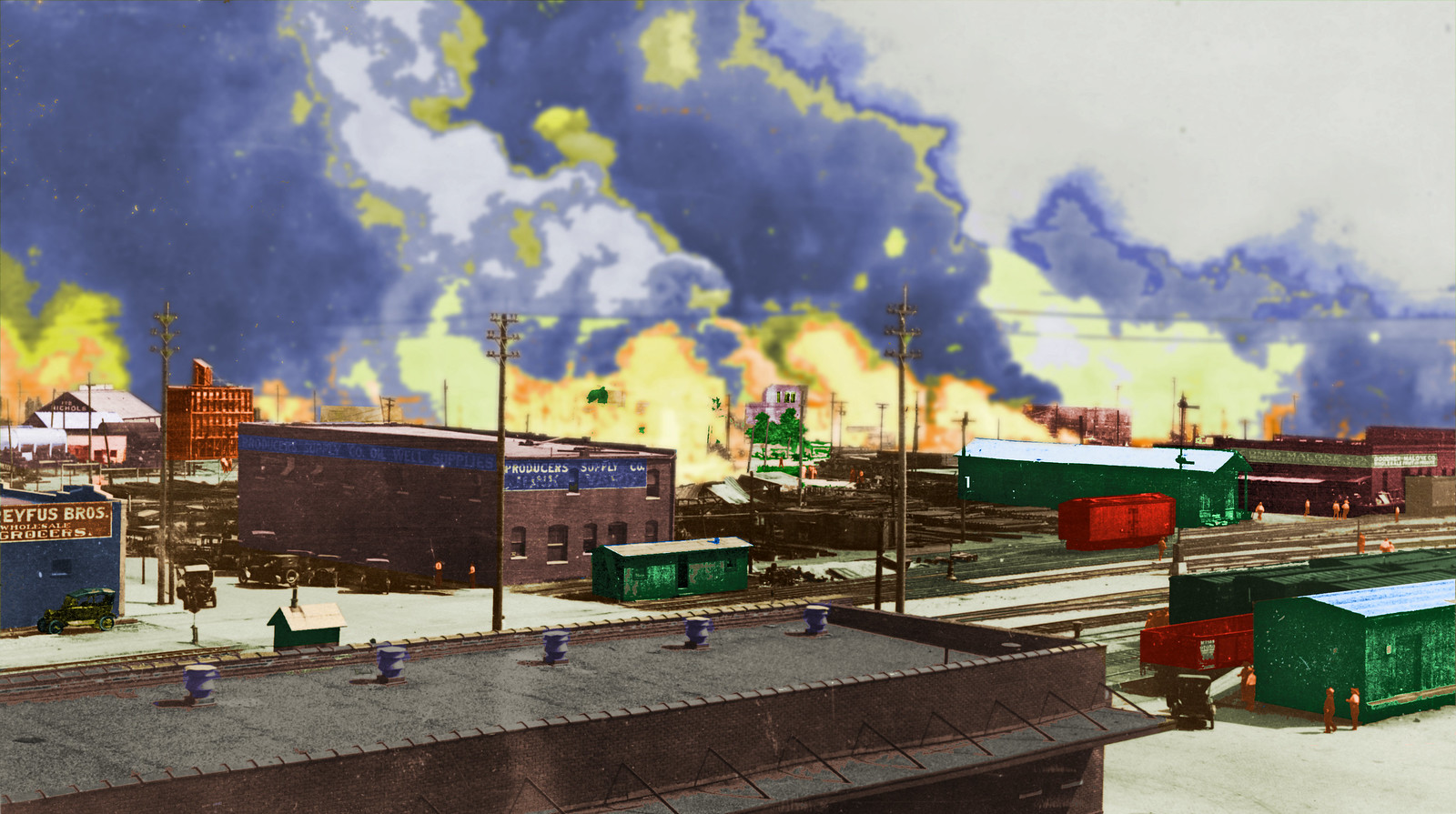
Colorized image from the Tulsa Race Riot. | The major fire in the center behind the Producers Supply Company
is the Midway Hotel in flames. The building behind it that you can see
is the Gurley Building burning. The flames to the right are from the
Williams Building. The as yet unburned building behind the building
behind the red train car is the Woods building at the corner of
Greenwood and Archer. Based on shadows this was taken about 8 in the
morning. Original photographer is unknown. Original photo
is 1989-004-5-28, McFarlin Library. Department of Special Collections
and University Archives, The University of Tulsa. Used with permission.: photo by Marc Carlson, 15 June 2012

Colorized image from the Tulsa Race Riot. | The major firein the center behind the Producers Supply Company
is the Midway Hotel in flames. The building behind it that you can see
is the Gurley Building burning. The flames to the right are from the
Williams Building. The as yet unburned building behind the building
behind the red train car is the Woods building at the corner of
Greenwood and Archer. Based on shadows this was taken about 8 in the
morning. Original photographer is unknown. Original photo
is 1989-004-5-28, McFarlin Library. Department of Special Collections
and University Archives, The University of Tulsa. Used with permission.: photo by Marc Carlson, 15 June 2012

Colorized image from the Tulsa Race Riot. | The major firein the center behind the Producers Supply Company
is the Midway Hotel in flames. The building behind it that you can see
is the Gurley Building burning. The flames to the right are from the
Williams Building. The as yet unburned building behind the building
behind the red train car is the Woods building at the corner of
Greenwood and Archer. Based on shadows this was taken about 8 in the
morning. Original photographer is unknown. Original photo
is 1989-004-5-28, McFarlin Library. Department of Special Collections
and University Archives, The University of Tulsa. Used with permission.: photo by Marc Carlson, 15 June 2012
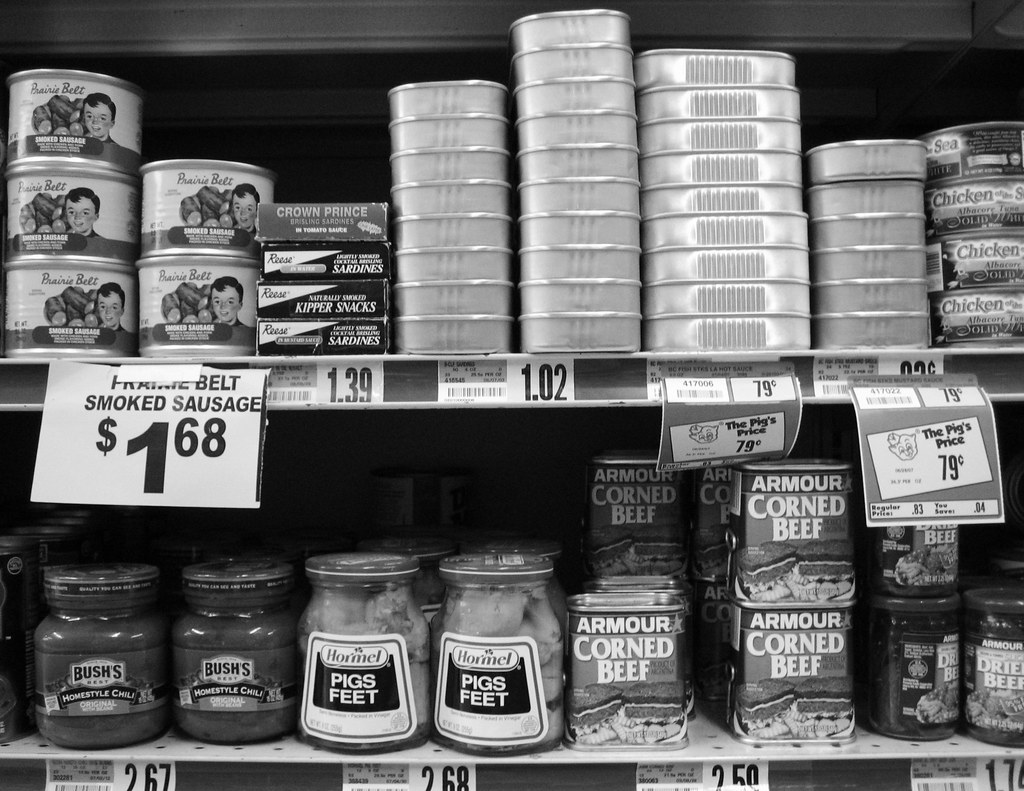
Canned Meats | In our canned food aisle [Collinsville, OK]: photo by Wade Harris, 23 May 2007
tarboat (2008): pig's feet are not something that appear in our local supermarket!
Wade Harris (2008): Tarboat: I worked in this store as an assistant manager twice, spaced
about two years apart, and I never did see anybody actually buy any
pig's feet. But...they seem to last forever so as far as I know those
have been the same jars all during that time.
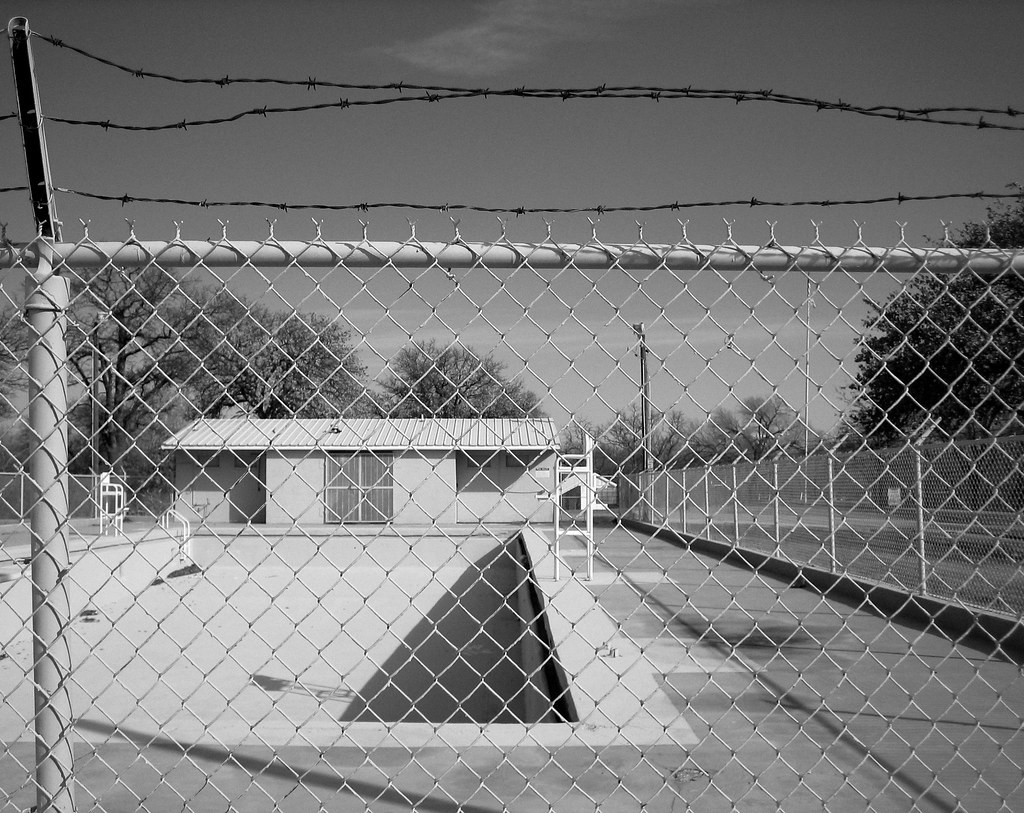
Barbed Wire Around Swimming Pool | Nothing adds
to the fun and jollyment of swimming on a hot summer day like a couple
of strands of rusty barbed wire on top of the fence surrounding the pool
you're in...... [Collinsville, OK]: photo by Wade Harris, 6 March 2007

Jackie Robinson signing autographs at Braves Field, Boston, 1948: photo by Michael Ryerson, 2 August 2018
There's a bitter-sweetness about this photo, for me. The kid with his hand on Jackie's shoulder. This is happening in Boston; Jackie is with the visiting Brooklyn Dodgers; at this point, neither of the Boston major league clubs has yet fielded a black player; this will remain the case for quite a few more years to come. Yet these Boston kids are openly adoring a hero.
Jackie was often angry, with cause; everywhere he went, he had to break down walls, and there was constant resistance. His defiance shone out in his aggressive, challenging style of play. I worked at the ballparks in Chicago, so got to see quite a bit of Jackie when the Dodgers were in town. He played with an intensity and edge that went beyond mere athletic competition; he was furiously competitive; but his adversary was never anything as simple as an opposing team or player. A slow fire burned in Jackie, and there were days when it flared up into something almost like majesty.
There was the day he was on third base, and dancing, feinting, as if taunting, intentionally provoking; finally he got what he wanted, a moment's distraction on the pitcher's part; in the space of that brief pause and the long unfolding moment that followed, the world had changed; Jackie had bolted for home; there was a collectively held breath, and then Jackie was sliding home, in a sudden bright cloud of dust.
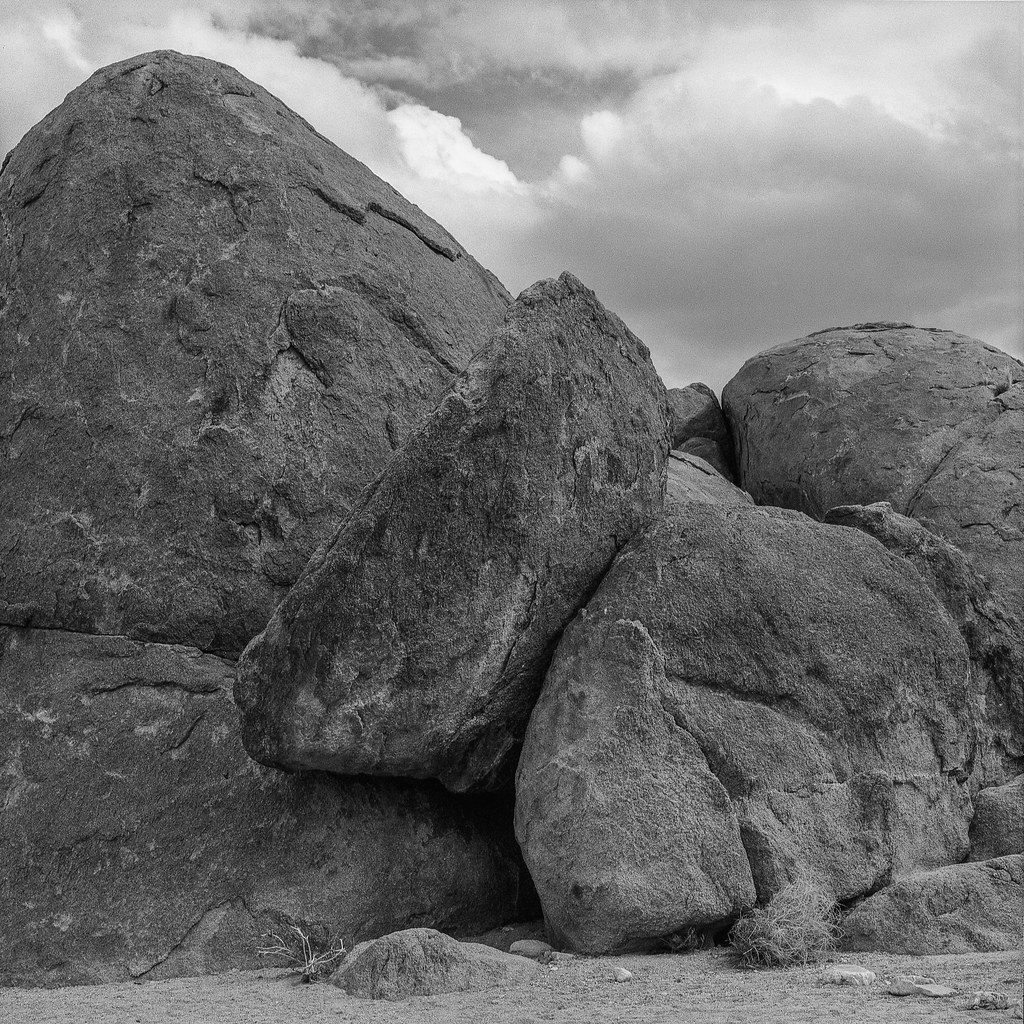
Dark rocks [California]: photo by Andrew Murr, 1 August 2018

Jackie Robinson signing autographs at Braves Field, Boston, 1948: photo by Michael Ryerson, 2 August 2018
There's a bitter-sweetness about this photo, for me. The kid with his hand on Jackie's shoulder. This is happening in Boston; Jackie is with the visiting Brooklyn Dodgers; at this point, neither of the Boston major league clubs has yet fielded a black player; this will remain the case for quite a few more years to come. Yet these Boston kids are openly adoring a hero.
Jackie was often angry, with cause; everywhere he went, he had to break down walls, and there was constant resistance. His defiance shone out in his aggressive, challenging style of play. I worked at the ballparks in Chicago, so got to see quite a bit of Jackie when the Dodgers were in town. He played with an intensity and edge that went beyond mere athletic competition; he was furiously competitive; but his adversary was never anything as simple as an opposing team or player. A slow fire burned in Jackie, and there were days when it flared up into something almost like majesty.
There was the day he was on third base, and dancing, feinting, as if taunting, intentionally provoking; finally he got what he wanted, a moment's distraction on the pitcher's part; in the space of that brief pause and the long unfolding moment that followed, the world had changed; Jackie had bolted for home; there was a collectively held breath, and then Jackie was sliding home, in a sudden bright cloud of dust.

Dark rocks [California]: photo by Andrew Murr, 1 August 2018



5 comments:
Howlin' Wolf: Smokestack Lightning (live, London 1964)
Great post, Tom. Ron's poem as reportage is stunningly effective. And Howlin' Wolf: what a formidable presence.
Many Thanks Terry. Agreed on both counts.
(I closed my eyes and imagined Wolf caught in the Burning of Little Africa.)
Jackie Robinson
Post a Comment